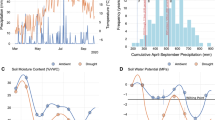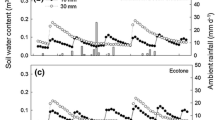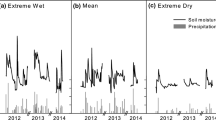Abstract
Arid and semi-arid ecosystems of the southwestern US are undergoing changes in vegetation composition and are predicted to experience shifts in climate. To understand implications of these current and predicted changes, we conducted a precipitation manipulation experiment on the Santa Rita Experimental Range in southeastern Arizona. The objectives of our study were to determine how soil surface and seasonal timing of rainfall events mediate the dynamics of leaf-level photosynthesis and plant water status of a native and non-native grass species in response to precipitation pulse events. We followed a simulated precipitation event (pulse) that occurred prior to the onset of the North American monsoon (in June) and at the peak of the monsoon (in August) for 2002 and 2003. We measured responses of pre-dawn water potential, photosynthetic rate, and stomatal conductance of native (Heteropogon contortus) and non-native (Eragrostis lehmanniana) C4 bunchgrasses on sandy and clay-rich soil surfaces. Soil surface did not always amplify differences in plant response to a pulse event. A June pulse event lead to an increase in plant water status and photosynthesis. Whereas the August pulse did not lead to an increase in plant water status and photosynthesis, due to favorable soil moisture conditions facilitating high plant performance during this period. E. lehmanniana did not demonstrate heightened photosynthetic performance over the native species in response to pulses across both soil surfaces. Overall accumulated leaf-level CO2 response to a pulse event was dependent on antecedent soil moisture during the August pulse event, but not during the June pulse event. This work highlights the need to understand how desert species respond to pulse events across contrasting soil surfaces in water-limited systems that are predicted to experience changes in climate.






Similar content being viewed by others
References
Adams DK, Comrie AC (1997) The North American monsoon. Bull Am Meteorol Soc 78(10):2197–2213
Anable ME, McClaran MP, Ruyle GB (1992) Spread of introduced Lehmann lovegrass Eragrostis lehmanniana Nees in southern Arizona, USA. Biol Conserv 61:181–188
Archer SR (1995) Tree–grass dynamics in a Prosopis-thornscrub savanna parkland: reconstructing the past and predicting the future. Ecoscience 2:83–99
Bahre CJ (1991) A legacy of change: historic human impact on vegetation in the Arizona Borderlands. University of Arizona Press, Tucson, Ariz.
Bahre CJ, Shelton ML (1993) Historic vegetation change, mesquite increases, and climate in southeastern Arizona. J Biogeogr 20(5):489–504
Boutton TW, Archer SR, Midwood AJ, Zitzer SF, Bol R (1998) delta C-13 values of soil organic carbon and their use in documenting vegetation change in a subtropical savanna ecosystem. Geoderma 82:5–41
Buckley TN (2005) The control of stomata by water balance. New Phytol 168:275–291
Burgess TL (1995) Desert grassland, mixed shrub savanna, shrub steppe, or semidesert scrub? The dilemma of coexisting growth forms. In: McClaran MP, Van Devender TR (eds) The desert grassland. University of Arizona Press, Tucson, Ariz., pp 31–67
Cohen D (1970) The expected efficiency of water utilization in plants under different competition and selection regimes. Isr J Bot 19:50–54
D’Antiono CM, Vitousek PM (1992) Biological invasions by exotic grasses, the grass-fire cycle and global change. Annu Rev Ecol Syst 23:63–87
Diffenbaugh NS, Pal JS, Trapp RJ, Giorgi F (2005) Fine-scale processes regulate the response of extreme events to global climate change. Proc Natl Acad Sci USA 102:15774–15778
Dukes JS, Mooney HA (1999) Does global change increase the success of biological invaders? Trends Ecol Evol 14(4):135–139
Easterling DR, Meehl CA, Parmesan C, Changnon SA, Karl TR, Mearns LO (2000) Climate extremes: observations, modeling, and impacts. Science 289:2068–2074
English NB, Weltzin JF, Fravolini A, Thomas L, Williams DG (2005) The influence of soil texture and vegetation on soil moisture under rainout shelters in a semi-desert grassland. J Arid Environ 63:324–343
Esque TC, Schwalbe CR (2002) Alien grasses and their relationships to fire and biotic change in Sonoran Desert scrub. In: Tellman B (eds) Invasive exotic species in the Sonoran region. University of Arizona Press, Tucson, Ariz., pp 165–194
Fay PA, Carlisle JD, Knapp AK, Blair JM, Collins SL (2003) Productivity responses to altered rainfall patterns in a C-4 dominated grassland. Oecologia 137:245–251
Flanagan LB, Wever LA, Carlson PJ (2002) Seasonal and interannual variation in carbon dioxide exchange and carbon balance in a northern temperature grassland. Global Change Biol 8:599–615
Frasier GW, Cox JR (1994) Water-balance in a pure stand of Lehmann’s lovegrass. J Range Manage 47:373–378
Grover HD, Musick HB (1990) Shrubland encroachment in southern New Mexico, U.S.A.: an analysis of desertification processes in the American Southwest. Clim Change 17:305–330
Hamerlynck EP, McAuliffe JR, Smith SD (2000) Effects of surface and sub-surface soil horizon on seasonal performance of Larrea tridentata (creosotebush). Funct Ecol 14:596–606
Hamerlynck EP, McAuliffe JR, McDonald EV, Smith SD (2002) Ecological responses of two Mojave Desert shrubs to soil horizon development and soil water dynamics. Ecology 83:768–779
Hamerlynck EP, Huxman TE, McAuliffe JR, Smith SD (2004) Carbon isotope discrimination and foliar nutrient status of Larrea tridentata (creosote bush) in contrasting Mojave Desert soils. Oecologia 138:210–215
Huxman TE, Smith MD, Fay PA, Knapp AK, Shaw MR, Loik ME, Smith SD, Tissue DT, Zak JC, Weltzin JF, Pockman WT, Sala OE, Haddad BM, Harte J, Koch GW, Schwinning S, Small EE, Williams DG (2004a) Convergence across biomes to a common rain-use efficiency. Nature 429:651–654
Huxman TE, Snyder KA, Tissue D, Leffler AJ, Ogle K, Pockman WT, Sandquist DR, Potts DL, Schwinning S (2004b) Precipitation pulses and carbon fluxes in semiarid and arid ecosystems. Oecologia 141:254–268
Huxman TE, Cable JM, Ignace DD, Eilts JA, English NB, Weltzin J, Williams DG (2004c) Response of net ecosystem gas exchange to a simulated precipitation pulse in a semi-arid grassland: the role of native versus non-native grasses and soil texture. Oecologia 141:295–305
Kerkhoff AJ, Martens SN, Milne BT (2004) An ecological evaluation of Eagleson’s optimality hypotheses. Funct Ecol 18:404–413
Kieft TL, White CS, Loftin SR, Aguilar R, Craig JA, Skaar DA (1998) Temporal dynamics in soil carbon and nitrogen resources at a grassland–shrubland ecotone. Ecology 79:671–683
Knapp AK, Smith MD (2001) Variation among biomes in temporal dynamics of aboveground primary production. Science 291:481–484
Knapp AK, Fay PH, Blair JM, Collins SL, Smith MD, Carlisle JD, Harper CW, Danner BT, Lett MS, McCarron JK (2002) Rainfall variability, carbon cycling, and plant species diversity in a mesic grassland. Science 298:2202–2205
Mack RN, Simberloff D, Lonsdale WM, Evans H, Clout M, Bazzaz FA (2000) Biotic invasion: causes, epidemiology, global consequences, and control. Ecol Appl 10:689–710
McAuliffe JR (1994) Landscape evolution, soil formation and ecological patterns and processes in Sonoran Desert bajadas. Ecol Monogr 64:111–148
McAuliffe JR (1995a) Landscape evolution, soil formation and Arizona’s desert grasslands. In: McClaran MP, Van Devender TR (eds) The desert grassland. University of Arizona Press, Tucson, Ariz., pp 100–129
McAuliffe JR (1999b) The Sonoran Desert: landscape complexity and ecological diversity. In: Robichaux R (ed) Ecology of Sonoran Desert plants and communities. University of Arizona Press, Tucson, Ariz., pp 87–104
McAuliffe JR (2003) The interface between precipitation and vegetation: The importance of soils in arid and semi-arid environments. In: Weltzin JF, McPherson GR (eds) Changing precipitation regimes and terrestrial ecosystems: a North American perspective. University of Arizona Press, Tucson, Ariz., pp 9–27
McClaran MP, Van Devender TR (1995) The desert grassland. University of Arizona Press, Tucson, Ariz.
Mooney HA, Hobbs RJ (2000) Global change and invasive species: where do we go from here? In: Mooney HA, Hobbs RJ (eds) Invasive species in a changing world. Island Press, Washington, D.C., pp 425–434
Naumburg E, Housman DC, Huxman TE, Charlet TN, Loik ME, Smith SD (2003) Photosynthetic responses of Mojave Desert shrubs to free air CO2 enrichment are greatest during wet years. Global Change Biol 9:276–285
Noy-Meir I (1973) Desert ecosystems: environment and producers. Annu Rev Ecol Syst 4:51–58
Ogle K, Reynolds JF (2004) Plant responses to precipitation in desert ecosystems: integrating functional types, pulses, thresholds, and delays. Oecologia 141:282–294
Potts DL, Huxman TE, Cable JM, English NB, Ignace DD, Eilts JA, Mason MJ, Weltzin JF, Williams DG (2006) Antecedent moisture and seasonal precipitation influence the response of canopy-scale carbon and water exchange to rainfall pulses in a semi-arid grassland. New Phytol 170:849–860
Parker KC (1995) Effects of complex geomorphic history on soil and vegetation patterns on arid alluvial fans. J Arid Environ 30:19–39
Reynolds JF, Paul RK, Ogle K, Fernandez RJ (2004) Modifying the ‘pulse-reserve’ paradigm for deserts of North America: precipitation pulses, soil water, and plant responses. Oecologia 141:194–210
Sala A, Smith SD, Devitt DA (1996) Water use by Tamariz ramosissima and associated phreatophytes in a Mojave Desert floodplain. Ecol Appl 6:888–898
Schlesinger WH, Reynolds JF, Cunningham GL, Hueneke LF, Jarrell WM, Virginia RA, Whitford WG (1990) Biological feedbacks in global desertification. Science 247:1043–1048
Schwinning S, Davis K, Richardson L, Ehleringer JR (2002) Deuterium enriched irrigation indicates different forms of rain use in shrub/grass species of the Colorado Plateau. Oecologia 130:345–355
Smith SD, Herr CA, Leary KL, Piorkowski JM (1995) Soil–plant water relations in a Mojave Desert mixed shrub community: a comparison of three geomorphic surfaces. J Arid Environ 29:339–351
Snyder KA, Donovan LA, James JJ, Tiller RL, Richards JH (2004) Extensive summer water pulses do not necessarily lead to canopy growth of Great Basin and northern Mojave Desert shrubs. Oecologia 141(2):325–334
Vitousek PM, Walker LR (1989) Biological invasion by myrica-faya in Hawaii—plant demography, nitrogen-fixation, ecosystem effects. Ecol Monogr 59:247–265
Walker LR, Smith SD (1997) Impacts of invasive plants on community and ecosystem properties. In: Luken JO, Thieret JW (eds) Assessment and management of plant invasions. Springer, Berlin Heidelberg New York, pp 69–86
Walter H (1979) Vegetation of the earth and ecological systems of the geo-biosphere, 2nd edn. Springer, Berlin Heidelberg New York
Weltzin JF, McPherson GR (2000) Implications of precipitation redistribution for shifts in temperate savanna ecotones. Ecology 81:1902–1913
Welztin JF, Tissue DT (2003) Resource pulses in arid environments-patterns of rain, patterns of life. New Phytol 157:171–173
Weltzin JF, Loik ME, Schwinning S, Williams DG, Fay P, Haddad B, Harte J, Huxman TE, Knapp AK, Lin G, Pockman WT, Shaw MR, Small E, Smith MD, Smith SD, Tissue DT, Zak JC (2003) Assessing the response of terrestrial ecosystems to potential changes in precipitation. BioScience 53:941–952
Williams DG, Baruch Z (2000) African grass invasion in the Americas: ecosystem consequences and the role of ecophysiology. Biol Invasions 2:123–140
Williams DG, Ehleringer JR (2000) Intra- and interspecific variation for summer precipitation use in pinyon-juniper woodlands. Ecol Monogr 70:517–537
Yan S, Wan C, Sosebee RE, Wester DB, Fish EB, Zartman RE (2000) Responses of photosynthesis and water relations to rainfall in the desert shrub creosote bush (Larrea tridentata) as influenced by municipal biosolids. J Arid Environ 46:397–412
Yepez EA, Huxman TE, Ignace DD, English NB, Weltzin JF, Castellanos AE, Williams DG. (2005) Dynamics of transpiration and evaporation following a moisture pulse in a semi-arid grassland: a chamber-based isotope method for partitioning flux components. Agric Forest Meteorol 132:359–376
Zavaleta ES, Thomas BD, Chiariello NR, Asner GP, Shaw MR, Field CB (2003) Plants reverse warming effect on ecosystem water balance. Proc Natl Acad Sci USA 100(17):9892–9893
Acknowledgements
The authors acknowledge the support of the USDA-CSREES (grant no. 00-35101-9308), the International Arid Lands Consortium, the University of Arizona, Sustainability of Semi-Arid Hydrology and Riparian Areas under the STC Program of the National Science Foundation, agreement no. EAR-9876800 and NSF awards DEB 041-5977, DEB 041-8363 and DEB 041-8134 to T. E. H., J. F. W., and D. G. W. D. D. I. was supported by the University of Arizona—Alfred P. Sloan Foundation Fellowship. J. Cable, D. Potts, A. Eilts, N. English, M. Mason, J. Chen and P. B. Allen assisted in the field.
Author information
Authors and Affiliations
Corresponding author
Additional information
Communicated by Alan Knapp.
Rights and permissions
About this article
Cite this article
Ignace, D.D., Huxman, T.E., Weltzin, J.F. et al. Leaf gas exchange and water status responses of a native and non-native grass to precipitation across contrasting soil surfaces in the Sonoran Desert. Oecologia 152, 401–413 (2007). https://doi.org/10.1007/s00442-007-0670-x
Received:
Accepted:
Published:
Issue Date:
DOI: https://doi.org/10.1007/s00442-007-0670-x




